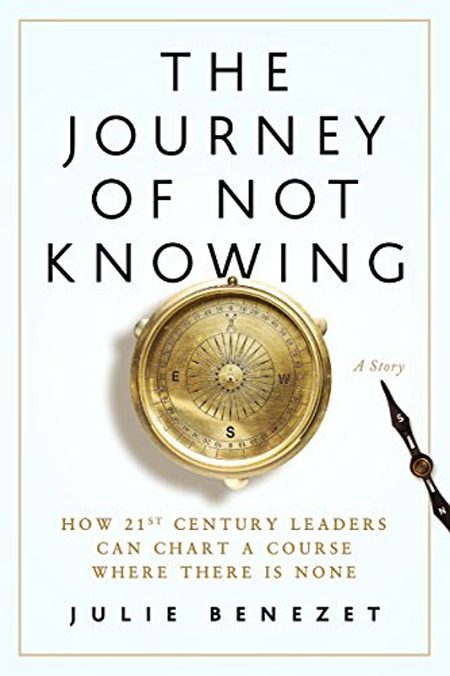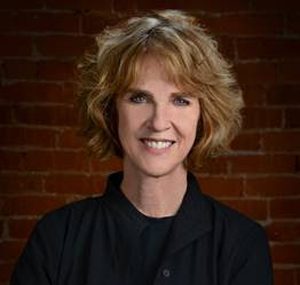

It’s 1999, and Julie Benezet is the new Director for a fledgling dot com called Amazon. Her challenge is to figure out how to lease just the right real estate and buildings in just the right places, to help the company survive and thrive. She has no idea how much space they are going to need, how many books they would be able to sell and ship, and how they will survive from day to day.
Her new book, “The Journey of Not Knowing: How 21st Century Leaders Can Chart a Course Where There Is None,” captures the lessons learned from over 25 years of navigating the unknown world of business and finance. Her adventurous career and remarkable achievements give her a unique management perspective that she shares with an unconventional clarity. She delves into the relationship between leadership and the unknown and explains how to chart a steady managerial course in uncharted territory filled with division and conflict.
“Entering the unknown releases the world of possibilities,” Benezet says. “It allows us to lead others to make the future happen. Being comfortable with the discomfort of not knowing is not easy. It calls on us to find our inner compass and see the world without varnish. We also learn to trust no matter how scary it gets, if we keep navigating those twisted pathways toward building something better, we will arrive there.”
How does a leader overcome these and other major issues that impede progress? Here are seven ways Benezet recommends for leaders to face the future in a world of divisive politics, shifting expectations and constantly looming unknowns:
 1. Your job is to lead your people into the future, not to stay stuck in the present. Your focus is not on business as usual, but business as it could be. Look for and create new opportunities in every aspect of organizational life, whether it is a company’s market position, work culture, talent development or new products. Seek and embrace ways to make life better for your employees, your customers and the communities you are engaged in. Learn what your stakeholders really need, and then come up with new, viable and effective ways to meet those needs.
1. Your job is to lead your people into the future, not to stay stuck in the present. Your focus is not on business as usual, but business as it could be. Look for and create new opportunities in every aspect of organizational life, whether it is a company’s market position, work culture, talent development or new products. Seek and embrace ways to make life better for your employees, your customers and the communities you are engaged in. Learn what your stakeholders really need, and then come up with new, viable and effective ways to meet those needs.
2. Embrace the fear of the unknown. Look upon the scary issues as an asset, not a liability. Strive to be a champion and not be faint of heart. The world has never been more ambiguous, scary and full of opportunities. Be willing to take on the risks of uncertain battles with uncertain outcomes that come with new ideas. Flex with your people and develop new organization processes that are capable of adapting to and leveraging every new situation as things play out differently from what was anticipated. Rejoice and celebrate with others when a new idea leads to something better for the organization.
3. Define the purpose that will drive your people and organization through the discomfort of not knowing the outcome of new ideas. The road to better outcomes is very uncomfortable. Try new ideas knowing and accepting that you will not be able to know what might happen. Allow yourself to be guided by a strong sense of purpose, a good sense of humor and a healthy dose of humility. Identify and embrace the ideals that give you and your people deep personal meaning. Turn these into the energy and power you need to face the challenges and make the best dreams really happen.
4. Accept failure on the way to success. Learn from every difficult lesson along the way. Test new ideas and find out whether they will be successful. Experiment with new ideas, technologies, approaches, systems and people. Embrace and celebrate failures especially when they are risky but laden with great potential. Congratulate and thank your people for their efforts and bravery. Look at bumps along the road as learning opportunities rather than reasons to slash headcount, slow down or abandon the quest. Use them to revise, improve and drive the organization forward. Restore their spirits and galvanize them so they persist in achieving success.
5. Recognize that human beings are messy. Learn to work with the difficulties they experience and help them overcome the challenges being faced. Avoiding your people in tough times is not an option. People come with their own set of requirements. Everyone is unique. There is no manual that guides in all circumstances. There is no way to predict what each person will do in any situation. Rise to every challenge and find the courage to connect with others. Humble yourself in a way that allows you to experience and understand them on their terms. Be willing to ask many questions to learn what your people see and seek. Resist being close-minded. Let others lead the conversation to surface the answers needed to create the best plan of action.
6. Be open to new knowledge and be critical of your self-knowledge, knowing that the right information can be hard to attain. Connect with new ideas and the people who can help make change happen. Develop and maintain an open channel that allows a free flow of education, uncluttered by fears and prejudices. Learn and explore who you are and how you got here. Separate and let go of the past so you can identify and act on what is relevant to the future.
7. Know when to move forward, even when you realize there is more to know. Realize that you can become only so familiar with the relevant facts and the personal agendas of others. You can never know everything there is to know. The world changes every second of every day. People change, facts change, situations change and opportunities come and go. Some decisions must be made so that people and the organization can move forward. Ask yourself – do we know enough to make a decision that is worth risking its unknown outcome? Ask your people to bring ideas forward if they see a risk that should influence or change the decision. Ask them for recommendations that will effectively manage and contain the risks. Decide to make the decision when you feel that the value of going forward is greater than not going forward.




